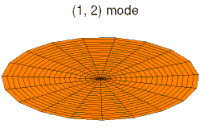
Photo from wikipedia
Membrane space structures have received widespread attention because of their small packaging volume and low mass. However, because membranes are very flexible and lightly damped, vibration suppression in membrane structures… Click to show full abstract
Membrane space structures have received widespread attention because of their small packaging volume and low mass. However, because membranes are very flexible and lightly damped, vibration suppression in membrane structures is very difficult. The objective of this study was to solve this problem. The first part of this article describes the influence of wrinkling in a membrane structure on the structure’s vibration characteristics. On this basis, the vibration deformations of a wrinkled square membrane structure were derived from the dynamic equations, and the correctness of this vibration model was verified by numerical simulation and experiment. A multi-model system is proposed to simulate the dynamic response of a membrane structure under different boundary conditions. In combination with the drive system, a multi-model switching control method based on adaptive and proportional–integral–derivative control is proposed. Under the initial disturbance, when the vibration amplitude dropped below 0.01 mm, the vibration duration was reduced to 2.96 s, compared with the duration of 12.37 s without control. The duration was shortened by approximately 39.7%, compared with the duration of 4.91 s achieved by the traditional proportional–integral–derivative control method, and by approximately 15.9% compared with the 3.52 s achieved by the out-plane control method. When there were multiple disturbances and the proposed method was used, the boundary displacement loadings did not increase when a certain value was exceeded. This prevented the breaking of the membrane by overstretching and provides a theoretical foundation for setting the initial pre-stress values.
Journal Title: Advances in Mechanical Engineering
Year Published: 2019
Link to full text (if available)
Share on Social Media: Sign Up to like & get
recommendations!